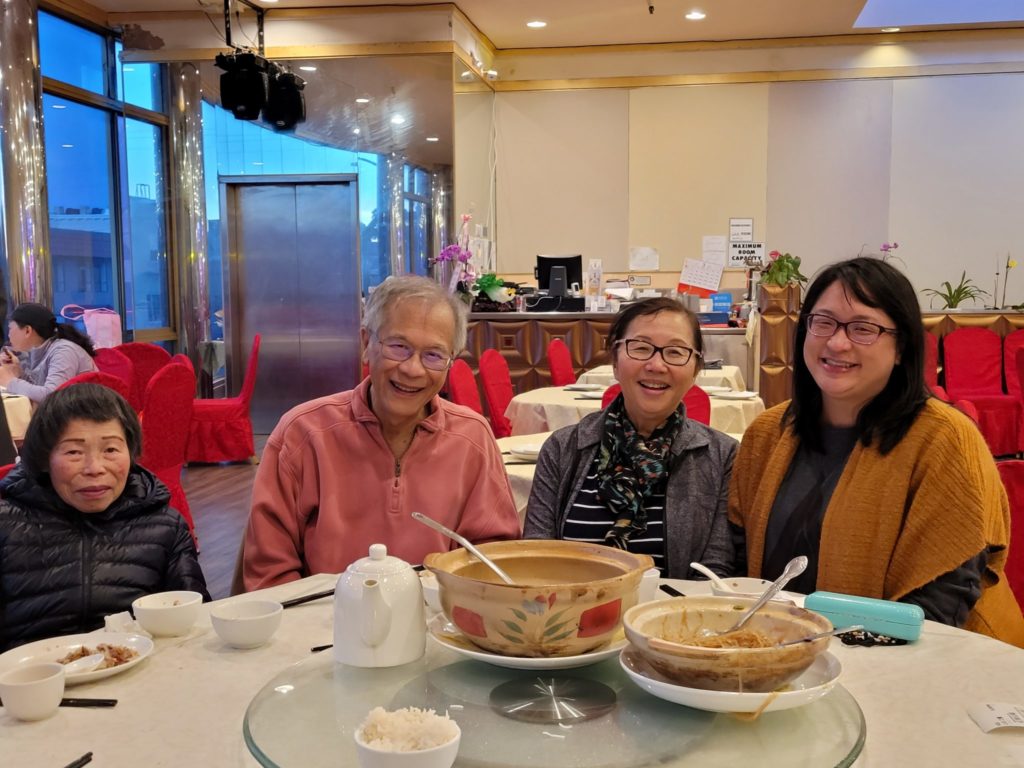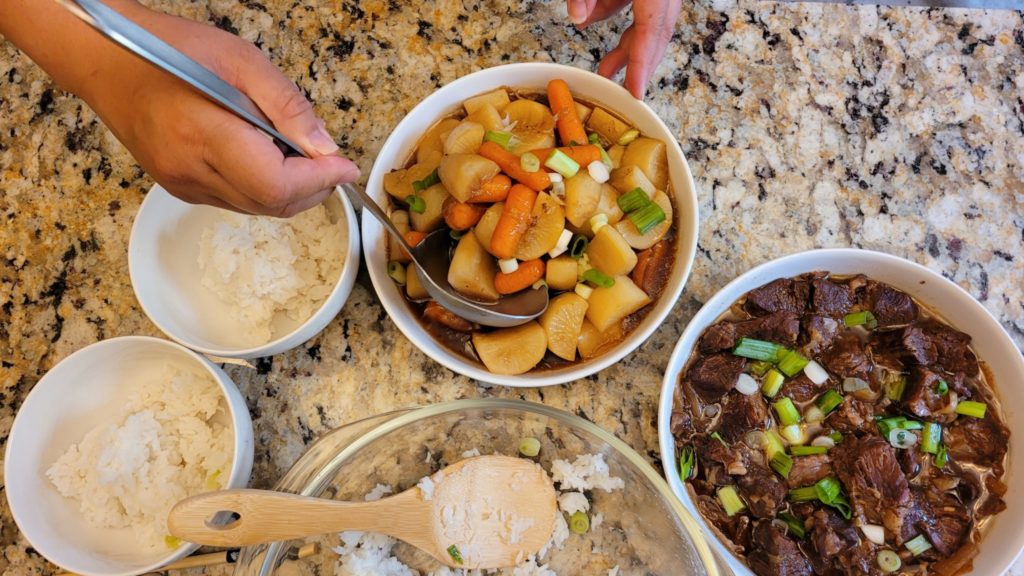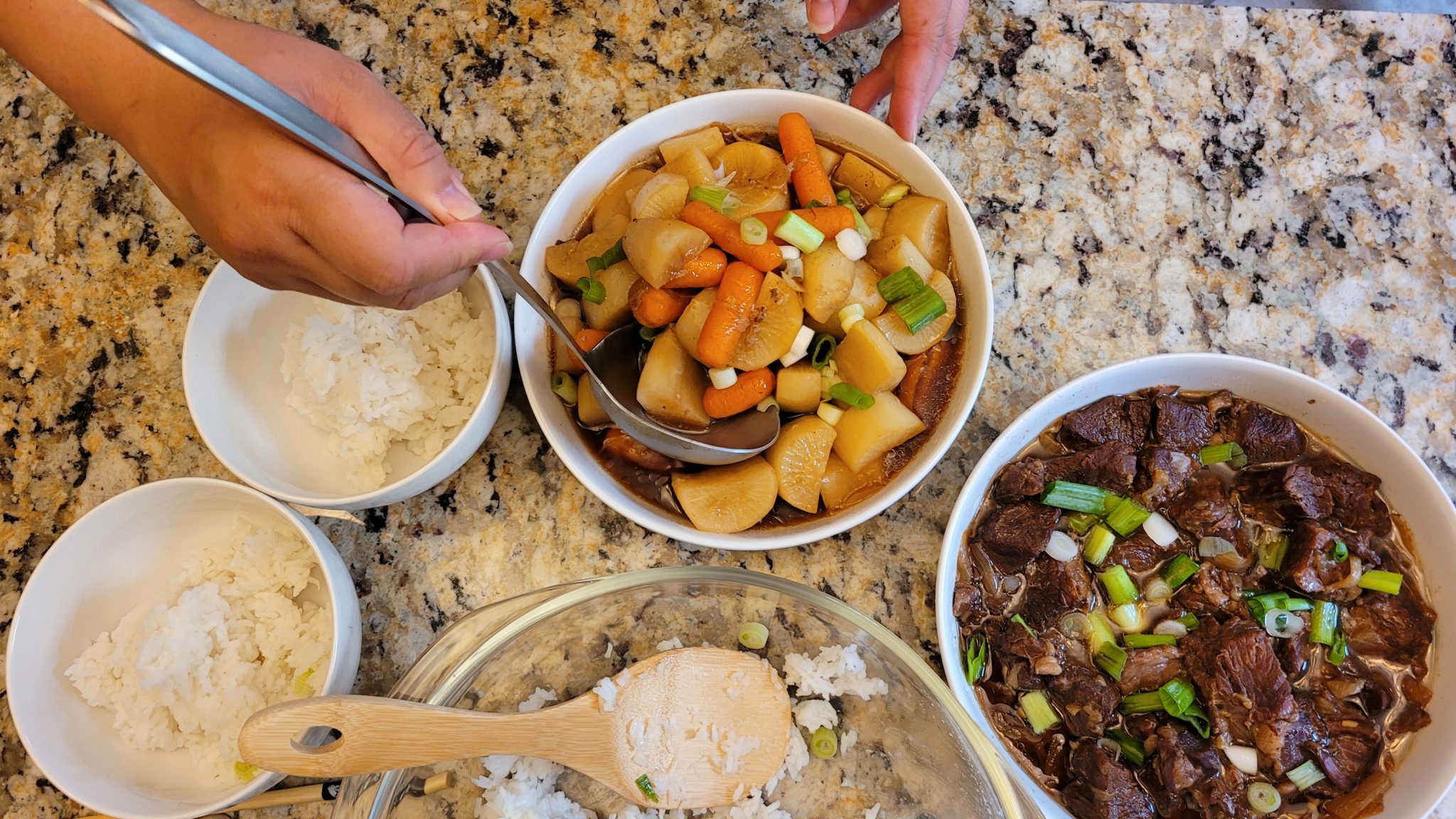I adore Cincinnati, and I love that it is a town for foodies. When I relocated to Cincinnati with my husband, I knew that Cantonese food might be harder to come by. As a blessing in disguise, I now explore Cincinnati’s culinary options with its plethora of markets where Asian food lovers buy hard-to-find ingredients. The options for food markets are tremendous.
I hope you join me on my culinary adventures and try some new foods. Reach out to me when you try this recipe for beef and daikon stew, and tell me how it tasted.
My History with Cantonese Food
I love traditional Cantonese-Chinese foods. It’s my heritage; my father’s family is Cantonese. When my father was five, he moved to San Francisco, California, from Taishan, China, a Cantonese region. Many of the Chinese people in San Francisco migrated from this region. As a first-generation Chinese-American, I grew up in San Francisco being part of the most common minority there. If you are curious, you can get a general rundown about who Cantonese people are from Wikipedia: “Guangzhou (historically known as Canton) and its surrounding area in Southeastern China,” and the Hong Kong area. In addition, Chung Ying’s blog is a great resource about Cantonese food.

Finding good Cantonese Chinese food and restaurants in San Francisco is easy. Beef and daikon stew was a favorite dish of mine for my family to order at restaurants. The dish is hearty, earthy, and delicious over rice or egg noodles.
Pre-COVID, I had never cooked too many Chinese dishes on my own. A silver lining to the pandemic was learning how to cook better. During the pandemic, I moved back to San Francisco to be closer to my grandmother, the matriarch of the Lee family, who owns the family’s multi-generational home. Part of the reason my husband and I moved into one of the units was to keep her company during what would have been a very lonely time for her. It was there that I learned to cook for my grandmother’s tastes while we were bunkered up with no restaurants to enjoy. Beef and daikon stew was one of our favorites for me to make on our weekly, big, Sunday dinners.
Where to Shop for Cantonese Food in Cincinnati
Jungle Jim’s is my “go-to” for Asian Foods. If you haven’t already fallen in love with Jungle Jim’s, it’s a must-see on your Cincinnati list of places to go.
I adore Jungle Jim’s because it is a one-stop shop for African, Middle Eastern, Eastern European, European, Hispanic, Indian, Asian, to American international foods. According to Jungle Jim’s, there are “200,000 square feet of shopping space in each of our stores, there are over 180,000 products from which to choose.” I enjoy shopping there for its robust Asian food section. The international market boasts several aisles dedicated to Asian foods organized into 10 countries, including — China, Japan, Thailand, Indonesia, Korea, Philippines, Taiwan, Hong Kong, Vietnam, and Malaysia.
On my last visit, I looked for ingredients for my Cantonese-inspired beef & daikon stew recipe. You can purchase all the ingredients needed for the stew (as well as other Cantonese food!) at Jungle Jims. In the recipe, I included ingredients that you can substitute with the items listed in the recipe. These substitutions can all be bought at Kroger or other Western/American stores. (Actually, when I was at Jungle Jim’s, I forgot to buy the daikon. I went to our local Kroger in Hyde Park, and discovered that they carry organic daikon.)
Some of the differences between traditional beef and daikon stew are that I used a pressure cooker instead of a clay pot; I used 5-Spice powder (cinnamon, cloves, fennel, star anise, and Sichuan peppercorns) instead of using the traditional whole cloves, star anise, and Sichuan peppercorns pieces; and substituted the beef rough flank for chuck roast. However, rough flank or drop flank — not to be confused with flank steak — is a tough, cut of meat that has tendon, sinews, gristly bits, and gelatinous pieces when slow cooked; it is difficult to find outside of Chinese/Asian markets. The instructions in the following recipe instruct to separate the cooking of the beef and the daikon, though I have also cooked the vegetables in a different order.
RECIPE: Instant Pot Beef & Daikon Stew
Ready in about 2 Hours
Serves 8 people
Appliances Instant Pot or Pressure Cooker

Ingredients
- 2lbs beef chuck roast
- 1.5 in of ginger or three slices
- 6 cloves of garlic crushed
- 1 medium onion roughly chopped
- ½ Tbsp of white pepper
- 1 Tbsp of sugar
- 2 Tbsp of 5-spice powder
- 1 Tbsp of dark soy sauce
- 1 Tbsp of hoisin sauce
- 1 Tbsp of soy sauce
- 2 Tbsp of oyster sauce
- 2 Tbsp of rice wine (i.e. Mirin or Shaoxing Wine)
- 3 bay leaves
- Water
- 1 medium to large daikon
- ½ lb of baby carrots
- 2 green onion stalks
- Serve with Jasmine white rice or your choice of Hong Kong noodles
Preparation
- Cut the beef chuck roast into stew-sized pieces. Roughly, the length of each side might be 1.5 inches to 2 inches depending on preference. Add beef to Instant Pot.
- Add ginger, garlic, onion, white pepper, sugar, 5-spice powder, dark soy sauce, hoisin sauce, soy sauce, oyster sauce, rice wine, and bay leaves to Instant Pot. Mix until sauce evenly coats the mixture.
- Pour water over the mixture until covering the ingredients.
- Place lid over Instant Pot. Set pressure on high for 30 minutes. It will take several minutes to come to pressure before the countdown starts.
- While beef is cooking, wash, peel, and cut Daikon in half length-wise and then cut into ¾-inch slices while the meat is pressure cooked.
- When the timer goes off, naturally vent for 15 minutes. This will help the meat continue slow cooking and become tender. Release the rest of the pressure and remove the lid.
- Remove beef and large solid pieces from Instant Pot leaving most of the broth in the pot. It’s okay if you leave some pieces behind.
- Add daikon and carrots to the broth.
- Place lid over Instant Pot. Set pressure on high for 12 minutes. Allow the pressure cooker to come to pressure before the countdown starts. Release pressure manually when the timer goes off.
- Remove vegetables. You can either add the vegetables to the beef or keep them separate in another bowl.
- Serve over rice or noodles.
- Garnish with chopped green onions.
Pro Tip
If you are a daikon fan and want to cook the vegetables with the meat for part of the time to infuse the flavors more, follow steps 1–5.
Then, when instead of naturally venting for 15min, release pressure manually. Add daikon and carrots to stew. Pressure cook for 10 minutes. Vent naturally for 5–10 minutes and then release the remaining pressure manually.
Substitutions
- Chuck roast: Brisket or rough flank (not to be confused with flank steak)
- White pepper: Black pepper
- 5-Spice powder: Chinese cinnamon, fennel seed, star anise, and cloves instead of
- Dark Soy Sauce: Soy sauce, teriyaki sauce, more oyster sauce, more hoisin sauce, double black soy sauce, Worcestershire sauce, mushroom-flavored dark soy
- Hoisin: Bean paste, garlic teriyaki, garlic and prunes, chili and plums, barbecue molasses, soy peanut butter, miso and mustard, ginger plum
- Oyster sauce: Fish sauce, hoisin sauce, Worcestershire sauce with soy sauce, teriyaki sauce, vegan mushroom sauce
- Rice wine: Pale dry sherry, gin & wine, Japanese rice wines, Mirin, Shaoxing
- Daikon: White turnips, radishes, parsnips, jicama, cabbage hearts
- Jasmine white rice: long grain white rice or long grain brown rice
- Hong Kong noodles: your choice of noodles
Feel free to print or share this recipe from Google Docs.



